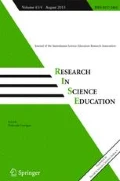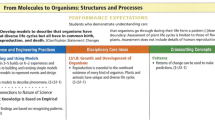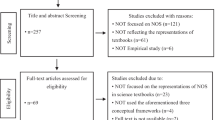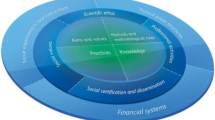Abstract
Scientific literacy not only involves scientific content relative to each branch of science, as a scientifically literate person is also aware of what science is, as well as how it operates in a broader and complex sense. Therefore, in order to develop and implement successful methodologies in the classroom aiming to improve students’ scientific literacy, it seems crucial to know what exactly science is. However, defining science turns out to be a complex problem inside the philosophy of science, and it has even been claimed that science cannot be defined. There are several strategies to face this problem in science education. Here, we show that most of the current strategies are lists of features trying to capture the nature of science, and we also show that the kind of strategies based on lists of features have insurmountable problems. We recognise the strengths and weaknesses of two main approaches, and building from those lessons we create a tool guiding the exploration of science nature which is free of the problems identified in previous approaches.
Similar content being viewed by others
Notes
For a review on the relevance of science education, see Aikenhead (2003), specially pages 15–26.
For a review on the problem of demarcation, see Hansson (2017).
The six demarcation criteria identified are as follows: a research programme, an epistemic field, a theory, a problem or question, or a particular inquiry. The author claim that ‘It is probably fair to say that demarcation criteria can be meaningfully applied on each of these levels of description. A much more difficult problem is whether one of these levels is the fundamental level to which assessments on the other levels are reducible.’(Hansson 2017).
Consensus NOS has been also criticised by stressing that the list might work as a ‘mantra’ or a ‘catechism’, discouraging critical thinking (Clough 2007) or arguing that it might lead to epistemic relativism (Romero-Maltrana et al. 2019), but such criticism is of another sort, they question the consequences and benefits of implementing ‘consensus NOS’ in contrast to the expected goals of scientific literacy.
Abd-El-Khalick et al. (1998) argue for an exhaustive preparation on nature of science topics for preservice teachers. Note that if the list of features increases without clear limit, then the goal of exhaustive preparation is untenable. However, the goal of preparing pre-service teachers about the nature of science is feasible if never ending lists of propositional knowledge are avoided, which is the strategy followed here.
We believe it should be stressed that the family resemblance approach (FRA) does not provide a demarcation criterion for distinguishing it from non-scientific activities. In fact, Dijk has pointed out that FRA implies that no general criterion for demarcating science is available (Dijk 2011, p. 1094).
Note that this problem is not exclusive to the consensus view, the extension of FRA done by Erduran and Dagher (2014) is essentially an inclusion of the social, political and financial constraints that are unavoidable in any sufficiently complex endeavour.
Note that Irzik and Nola (2011) included the category ‘Values’ jointly with the category ‘Aims’. It can be argued that ‘values’ are important enough to have a category by themselves as del Mar Aragón-Méndez et al. (2018) would suggest. In fact, Khun demarcated different activities through different sets of ‘values’ (Kuhn 1970). However, it can also be argued that values are items inside certain meta-categories depending on the human endeavour analysed, e.g. moral codes are products of religion, but they also serve as methods to human health medicine, and as an aim to human rights policies. Therefore, in our approach, values are not considered an independent meta-category.
There is an important difference between Irzik and Nola’s approach and that of Erduran and Dagher. The categories proposed by Irzik and Nola aim to capture the nature of science from within, whereas the three categories proposed by Erduran and Dagher are external constraints that certainly influence the endeavour, but do not distinguish it from others.
Paradigms are stable sets of features characterising periods of normal development of science, with well established: methods of theoretical and experimental research, communities of participants, knowledge about what has to be measured and how, reference books that are used in the instruction of new participants. Any case or anecdote related to the scientific endeavour that contains all the elements of the ‘paradigm matrix’ can safely be considered as a mature and representative example.
The use of cases to promote NOS learning is not exclusive to this proposal. According to (del Mar Aragón-Méndez et al. 2018, p.4) the case study, specifically the use of socio-scientific issues, is ‘the most appropriate context for learning NOS, among scientific inquiry and History of Science (HOS)’. The socio-scientific issues are a special type of a case study, and the HOS is, precisely, the consideration of historically relevant events and processes to learn about NOS.
This article aim to set the conceptual basis for future empirical studies assessing this tool. For such future works, teaching-learning sequences has to be created and implemented, but this lay beyond the scope of this article.
Data from 2013, see https://en.unesco.org/unesco_science_report/figures, page visited on Jun 2019.
References
A.A.A.S. (1993). Benchmarks for science literacy. USA: Oxford University Press.
Abd-El-Khalick, F., Bell, R. L., & Lederman, N. G. (1998). The nature of science and instructional practice: making the unnatural natural. Science Education, 82(4), 417–436.
Aikenhead, G. S. (2003). Review of research on humanistic perspectives in science curricula. In 4th conference of the european science education research association (ESERA), research and the quality of science education. The Netherlands: Noordwijkerhout.
Alters, B. J. (1997). Whose nature of science? Journal of Research in Science Teaching, 34(1), 39–55.
Biggs, J. B., & Collis, K. F. (2014). Evaluating the quality of learning: the SOLO taxonomy (Structure of the Observed Learning Outcome). Cambridge: Academic Press.
Bloom, B. S., Engelhart, M. D., Furst, E. J., Hill, W. H., & Krathwohl, D. R. (1956). Taxonomy of educational objectives: the classification of educational goals. Handbook i: cognitive domain. New York: David McKay Company. Inc.(7th Edition 1972).
Bybee, R. (2015). Scientific literacy, (pp. 944–947). Netherlands, Dordrecht: Springer.
Bybee, R. W. (1997). Achieving scientific literacy: from purposes to practices. Westport: Greenwood Publishing Group, Incorporated.
Clough, M. P. (2007). Teaching the nature of science to secondary and post-secondary students: questions rather than tenets. In The pantaneto forum, (Vol. 25 pp. 31–40).
DeBoer, G. E. (2000). Scientific literacy: another look at its historical and contemporary meanings and its relationship to science education reform. Journal of Research in Science Teaching, 37(6), 582–601.
del Mar Aragón-Méndez, M., Acevedo-Díaz, J. A., & García-Carmona, A. (2018). Prospective biology teachers’ understanding of the nature of science through an analysis of the historical case of Semmelweis and childbed fever. Cultural Studies of Science Education, pp. 1–31.
Dijk, E. M. v. (2011). Portraying real science in science communication. Science Education, 95(6), 1086–1100.
Ellis, A. K., Denton, D. W., & Bond, J. B. (2014). An analysis of research on metacognitive teaching strategies. Procedia-Social and Behavioral Sciences, 116(21), 4015–4024.
Erduran, S., & Dagher, Z. R. (2014). Reconceptualizing nature of science for science education. Springer.
Gojkov, G., Stojanović, A., & Rajić, A. G. (2015). Critical thinking of students–indicator of quality in higher education. Procedia-Social and Behavioral Sciences, 191, 591–596.
Hansson, S. O. (2009). Cutting the gordian knot of demarcation. International Studies in the Philosophy of Science, 23(3), 237–243.
Hansson, S. O. (2017). Science and pseudo-science. In Zalta, E. N. (Ed.) The Stanford Encyclopedia of Philosophy. Metaphysics Research Lab, Stanford University, summer 2017 edition.
Hattie, J., & Timperley, H. (2007). The power of feedback. Review of Educational Research, 77(1), 81–112.
Hodson, D. (2016). Making the case for case studies. Studies in Science Education, 52, 67–81.
Irzik, G., & Nola, R. (2011). A family resemblance approach to the nature of science for science education. Science & Education, 20(7–8), 591–607.
Irzik, G., & Nola, R. (2014). New directions for nature of science research. In International handbook of research in history, philosophy and science teaching (pp. 999–1021). Springer.
Kuhn, T. S. (1970). The structure of scientific revolutions, 2nd edn. Chicago: University of Chicago Press.
Laudan, L. (1983). The demise of the demarcation problem. In Physics, philosophy and psychoanalysis (pp 111–127). Springer.
Lederman, N. G., Abd-El-Khalick, F., Bell, R. L., & Schwartz, R. S. (2002). Views of nature of science questionnaire: toward valid and meaningful assessment of learners’ conceptions of nature of science. Journal of Research in Science Teaching, 39(6), 497–521.
Lederman, N. G., Bartos, S. A., & Lederman, J. S. (2014). The development, use, and interpretation of nature of science assessments. In International handbook of research in history, philosophy and science teaching (pp. 971–997). Springer.
Lederman, N. G., & Lederman, J. S. (2014). Is nature of science going, going, going, gone? Journal of Science Teacher Education, 3(25), 235–238.
Marzano, R. (2001). Designing a new taxonomy of educational objectives. Experts in assessment. Thousand Oaks: Corwin Press.
Matthews, M. R. (2012). Changing the focus: from nature of science (nos) to features of science (fos). In Advances in nature of science research (pp. 3–26). Springer.
McComas, W. F. (1996). Ten myths of science: reexamining what we think we know about the nature of science. School Science and Mathematics, 96(1), 10–16.
McComas, W. F. (2002). The principal elements of the nature of science: dispelling the myths. In The nature of science in science education, (pp. 53–70). Springer.
MINEDUC. (2016). Programa de estudio primero medio. Ministerio de Eduación Chile.
National-Curriculum-Council. (1988). Science in the national curriculum. York: NCC.
N.C.S.E.S.A., N.R.C., B.S.E., & D.B.S.S.E. (1995). National science education standards. National Academies Press.
Osborne, J., Collins, S., Ratcliffe, M., Millar, R., & Duschl, R. (2003). What “ideas-about-science” should be taught in school science? a delphi study of the expert community. Journal of Research in Science Teaching, 40(7), 692–720.
Pintrich, P. R. (2002). The role of metacognitive knowledge in learning, teaching, and assessing. Theory Into Practice, 41(4), 219–225.
Popper, K. (2002). The logic of scientific discovery. Routledge Classics. Routledge.
Resnik, D. B. (2000). A pragmatic approach to the demarcation problem. Studies in History and Philosophy of Science Part A, 31(2), 249–267.
Romero-Maltrana, D., Benitez, F., Vera, F., & Rivera, R. (2019). The ‘nature of science’ and the perils of epistemic relativism. Research in Science Education, 49(6), 1735–1757.
Rudolph, J. L. (2000). Reconsidering the ‘nature of science’ as a curriculum component. Journal of Curriculum Studies, 32(3), 403–419.
Rutherford, F., & Ahlgren, A. (1991). Science for all americans. USA: Oxford University Press.
Shen, B. S. (1975). Science literacy and the public understanding of science. In Communication of scientific information (pp. 44–52). Karger Publishers.
Yang, F.-Y., & Tsai, C.-C. (2012). Personal epistemology and science learning: a review on empirical studies. In Fraser, B., Tobin, K., & McRobbie, C. J. (Eds.) Second International Handbook of Science Education, chapter 19, (pp. 259–279). Springer.
Author information
Authors and Affiliations
Corresponding author
Additional information
Publisher’s Note
Springer Nature remains neutral with regard to jurisdictional claims in published maps and institutional affiliations.
Rights and permissions
About this article
Cite this article
Romero-Maltrana, D., Duarte, S. A New Way to Explore the Nature of Science: Meta-categories Rather Than Lists. Res Sci Educ 52, 239–257 (2022). https://doi.org/10.1007/s11165-020-09940-y
Published:
Issue Date:
DOI: https://doi.org/10.1007/s11165-020-09940-y




